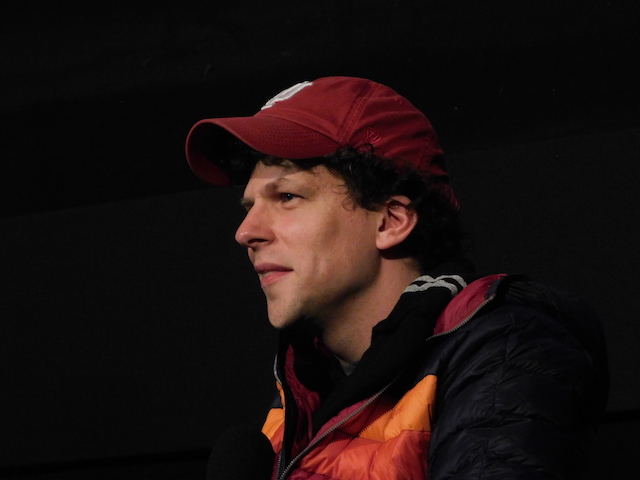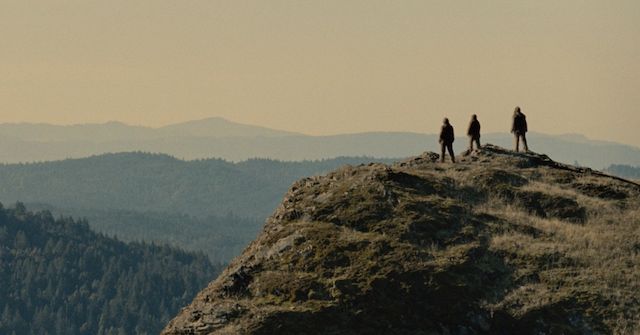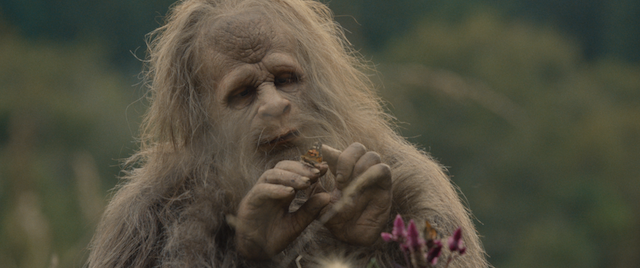
©Courtesy of Bleecker Street
Sasquatch Sunset : In the misty forests of North America, a family of Sasquatches–possibly the last of their enigmatic kind–embark on an absurdist, epic, hilarious, and ultimately poignant journey over the course of one year. These shaggy and noble giants fight for survival as they find themselves on a collision course with the ever-changing world around them. Starring Riley Keough and Jesse Eisenberg, acclaimed directors David and Nathan Zellner (Kumiko, the Treasure Hunter) bring you the greatest Bigfoot story ever told.
Director : David Zellner, Nathan Zellner
Producer : Ari Aster, Gus Deardoff, Lizzie Shapiro, Andrew Karpen, Kent Sanderson, Riley Keough, Gina Gammell, Jeff Hull, Ross Boucher, Michael Clofine
Screenwriter : David Zellner
Distributor : Bleecker Street
Production : CoFelix Culpa, Square Peg, The Space Program, ZBI
Rating : R (Bloody Images|Some Sexual Content|Full Nudity)
Genre : Comedy, Action, Adventure

Q: You produced this. After you read the script, what kind of dreams did you have for it?
Jesse Eisenberg: I produced it. What happened was it had funding from one financier in Spain. It was a legitimate source of funding. I think the money fell out maybe two months before or two weeks before [production was to begin]. I was thinking, “I’ve never done anything like this in my life.” I just thought this movie had to be made, something so original, so pure. It’s this tiny, tiny movie. I wasn’t even thinking so much about the thrill of acting in it, because it’s an experience doing all that. I just felt I’ll do whatever I can to get it made. They’re making all these other movies that are so awful.
Q: You did a boot camp to prepare. What was obviously done creating the family dynamic between all of you?
Jesse Eisenberg: The first thing we did as a cast was Zoom with each other. I had hired this teacher. I did a movie where I played Marcel Marceau. And my teacher for a year and a half, was a guy named Laurent. He’s one of the great, moving people in the world, and had a very classy background, who had studied with Marceau before he died. I asked him, could you do this movie where we’re doing Sasquatches and [teach] walking like Sasquatch?
The first thing we did was in our own homes, to clear enough space in our apartments, and go on Zoom. With the Zoom, we put the camera at the very end of the room, and just walked back and forth like Sasquatches, and we looked so absurd. I don’t remember if that moved our lives or if it moved other people’s lives, but essentially, that was one of the weird things that we did.
Then we got together, did this boot camp, like any person, where we moved to the silliest things you could possibly imagine, like eating raw leaves and the way the leaves dribble down from your mouth, or like [catching] the salmon and the way you gnaw it in a feral way, interacting with each other, and our own characters. My character, I’d like to think of as a poet. You saw him at the end, you see him with this butterfly and I just thought this character is somebody who would look up to nature as opposed to what we think of as the cliches.
You have the proposition to do a movie with prosthetics, so make sure you love it so much because after an hour you want to kill that person [who suggested doing it]. You’re driving two hours in the morning. This is a very remote wilderness site. At four in the morning, you get glue on every inch of your face. Then yak hair, and then prosthetics. You feel so uncomfortable, and then the day has just begun.
I got into a suit that was made for a person much tighter than me. It has to fit with every muscle in your body, or in my case, my sinew. Then you’re eating in this thing all day. I don’t know if you remember it, but the first time I saw the Sasquatch were when they were walking across this big field. That was the most exhausting day of my life. Basically, we got to the end of the field and we were just lying on the ground. It was the first day, just looking at each other like that’s the worst thing that ever happened. The movement of your body was exhausting. I don’t want to ask for pity, but I deserve it.
This was all shot on location. I’m sure that this physicality I had experienced before but this was really doing physical labor, which, now seeing it again, [was especially exhausting me and] for the feet. It’s just physically taxing, it was exhausting, and the only thing that made it great would be like looking [at yourself] in the mirror. You’d have to go to pee mercilessly halfway through the day, which is like a whole process anyway. Then you’d look into the mirror, and think, “I’m in this amazing world of art. I am so privileged to be in this thing. It was amazing.”
That would be it for today. But not the next day. I think there’s a lot of the fear being so feral, getting to do all this. I love seeing her eat a fish. I think it’s cool, gross stuff in a way that you don’t have to even overthink it. I’ve had the experience in a few movies where the movies are not taking place exactly in the real world and it gives you a permission, a structure to act in ways that are not a societal kind of way. As an actor, I absolutely adored those. This was just different. the characters were so fearful, but to do anything requires such it has. So yeah, the fish scene.
A really funny example is the scene where we pee on the road. The tube was down my body, and it came out of the penis. At first, it was barely in the ass. I think some of my yak hair from my character’s penis was in the thing. You’re just standing there waiting for the pee to come out. Right before the pee comes out, we’re screaming. We’re all terrified of this thing, or want to dominate. It’s like, “Ah! you work up to this big thing that’s exhausting, and then in the heat of it, it doesn’t come out right.

©Courtesy of Bleecker Street
Q: In the movie, there are these spontaneous, messy things, but there’s so much technical stuff being in the costume that affects spontaneity.Was there any improv at all?
Jesse Eisenberg: There was probably something in working with animals. There was a cute scene where I sat down with the badger. The idea with that is, because I’m trying to [have] the female out in the native ferns, and she rejects me. So the idea is like, “Oh, I’ll go sit down. The bad guy is the badger. Then we were working with animals. if it was a regular movie I’d know what the animal would be doing right before it did it. We were working with animals that every animal that started in the sanctuary, they were real.
Q: What kinds of things guided you through a lot of these scenes, like in terms of the thought processes and the physical nature of it?
Jesse Eisenberg:The script was so good. I had just been asking and hoping that it’s published or leaked or whatever. The script is so brilliant. I really think if anybody reads this and sees the movie, what they’ll see is, “Oh, I see how clear this thing is.” There was imagination on set and they let us play with it.
But really, the script was so brilliantly detailed that when you read it, you pick it up. I’ve had this experience a lot of the time. I was in “Zombieland.” I was on that set, and it was a similar experience. It was such a zany movie, but the script was so clear that every actor in the movie did exactly every shot that we needed. It was the same thing with this. We’d light up every single shot we needed together because the script and the story and the scene are so clear.
Q: How was it filming the last scenes?
Jesse Eisenberg: That’s so important and sad, and it just feels like the sort of climax of the film. I’ve tried to explain this so many times. It’s so scary. it just makes me ask, “Why do they do that? Why do they get scary scenes in a movie?” It’s something substantial that I can’t fully answer. But yeah, basically, we scouted the river, where the log is, in August, and we’re shooting in November. It turned from this beautiful river to a freezing, awful river. It’s the nature of scouting for a movie and then shooting. Sometimes you scout for winter and you dress all the actors in warm clothes and then you’re shooting in the summer and everything’s all funny.
Basically, it occurred to me that really the only set in this entire movie is just the close-up on my face as I’m dying, which we couldn’t get in the cold. I couldn’t stay under because the water would go in; it was so cold. I put some leaves and dirt out of the pool. We filmed it, and the water was heated. I don’t know how it all came together, but basically we did that close up in this little wavy pool right off the side of the river. Otherwise, it was all practical. No one knows where they’re working. It was just amazing. I really couldn’t see what they were doing. All I know is what I’ve seen in the movie. It’s my favorite shot in the movie that I’ve seen.
If you remember, this scene where Riley [Keough] is trying to get out of the water, and she realizes she can’t. She’s just slowly getting the tendency to rush her hand against the water, basically helpless, but not getting up. It’s been a masterful performance by her. It’s just amazing acting. I’m so glad I got to see it when I was there, I was really just grabbing onto the thing, literally, practically. Riley’s husband was the coordinator. I worked with him a few times. Ben Smith, a lovely, lovely person. He was the sound coordinator on the movie.
It was a family experience with the mountain lion. They were throwing rocks at the mountain lion. Yes, so cute. The mountain lion was the only animal on the set. We were told not to make eye contact with him. He had the owners who were behind him. Clearly, a genuinely scary creature. It was habitat-wise and very charming. I did, and didn’t, have a shot of it, we were driving away in a van, and it was just scary. That was the first time I was in a room where there was something like, in nature, that was a warning.

©Courtesy of Bleecker Street
Q: You mentioned, it’s so non-verbal. How was it figuring out what you were to sound like?
Jesse Eisenberg: Oh, yeah, there are all sorts of mythology that conflicts with itself, about Sasquatches that claim to be the old minute factual version, and also mythology that conflicts with that old version. We have all these sounds that people have been playing that were recorded from the Sasquatch. You wonder, though. I don’t disbelieve in the Sasquatch or believe in it, I don’t know. I hope it exists, because It’s this beautiful link to nature and to our ancestry.
I love the mythology of the Sasquatches, but it’s a little curious that there’s a lot of sound recording of Sasquatches and not videos. We had to pick and choose what sounds were right, and what sounds we actually made, because some of the sounds online are really human— it’s some machine or something creating it. We figured out a vocabulary for this category, we were basically a dictionary. It’s a single page. But we created the smallest dictionary in the world. Basically, when we’re calling out for sasquatches, it’s woo! The other funny thing, with my golden retriever, when she’s eating, if you go in a 15 foot radius of the dog eating, and [come near] the bowl is just “grr, grr, grr.” The closer you get, the louder the “grr”comes, until you’re right there, then she [loosens] up.
Q: Was there interest in reaching out to others? What was their goal?
Jesse Eisenberg: It’s basically the story of survival. You’re seeing these creatures that are, let’s say, primitive. You’re seeing a story of real survival, of feral creatures trying to survive. The theory around our family is that it was Nathan [Zellner] and Riley, the alpha female who made this child, not me. I kind of hang around, and help the family survive. The idea is, looking out for others. As much as the mythology is really about the isolated creatures, not living in packs, but of course, they’re like any other humanoid species.
Q: How did these pure, non-self-conscious creatures express themselves?Sometimes there’s slapstick quality to them, sometimes there’s an honesty to it. How did you express it?
Jesse Eisenberg: The comedy in this is just up my alley. I don’t know what that says about me or whether we’re here to grow up. I’ve been in a few movies that have this kind of comedy. The other three movies that I’ve been in that are comparable to this are my self-defense. I did a movie called “Living Wake,” which you almost didn’t even hear of. As I mentioned earlier, those three movies have what I would call an earnestness at their core.
You can cry, you can feel all the pain and the feelings you would feel in a drama, but the world around it is skewed in a way that’s comic. For me as an actor, that’s just the ultimate possible achievement in terms of tone. The next movie that I directed is [“A Real Pain”], and I tried to agree with that tone. It’s the tone I most aspire to. What I love about acting is feeling the emotions and the catharsis. What I don’t love about the mental drama is the self-importance and the way it can alienate itself from the audience. To me, if you can have this real acting, which is heartbreaking and real, but set it in a world that’s, let’s say, unpretentious.

©Courtesy of Bleecker Street
Check out more of Nobuhiro’s articles.
If you liked the article, share your thoughts below!
Here’s the trailer of the film.

